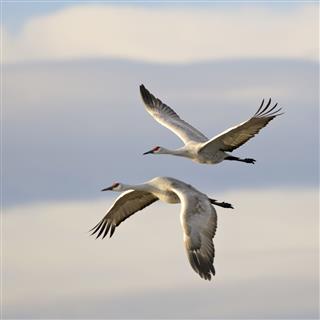
One of the largest and common herons in North America, the tall, long-legged Great Blue Heron is easily spotted along the shores or edges of small inland ponds. Did you know that this magnificent bird can fish both during the night as well as the day?
Around summer and spring, Great Blue Herons tend to breed all over North and Central America, most of Canada, the Galápagos Islands, and the Caribbean. Some populations like to migrate towards Central and South America. They are considered expert fishers. They walk slowly or stand absolutely still for a long time, and wait for their prey. As soon as the prey is close enough, they deliver a deathly blow by thrusting their sharp bill in the water, and swallowing the entire prey with ease.
Range and Habitat
Belonging to the Ardeidae family, the Herons’ family includes egrets, night herons, and bitterns as well. Around the world, the Ardeidae family contains approximately 60 species. As we discussed earlier, the population of Herons is spread across North America, their range also includes Mexico, British Columbia, Quebec, New Brunswick, and Nova Scotia. As they like to live near water bodies, you can also find them amidst mangroves, swamps, edges of lakes, marshes, and flooded meadows.
A long neck can be hazardous
As Herons attempt to swallow their prey whole, they have been known to choke to death at times. Their long, S-shaped necks makes it difficult for them to swallow fish which are too long or large.
A varied diet
The primary diet of Herons consists of fish. However, they can quickly adapt to eating other animals like mice, frogs, lizards, snakes, dragonflies, grasshoppers, salamanders, crabs, shrimp, crayfish, small mammals, invertebrates, amphibians, and other aquatic insects.
Call of the wild
Blue herons are quieter as compared to other similar species. They make calling sounds such as “kraak”, “fraunk”, and “ar” when they are interrupted while flying, feel agitated or threatened close to their nests, and when they come in contact with other species respectively.
Types and subspecies
The Herons play an important role in the ecosystem. These birds help control population of fish and insects from various habitats. Also, herons are a source of food for animals like red-tailed hawks, bears, raccoons, eagles, and turkey vultures. There are 7 known subspecies of the Herons, one of which is the Great White Heron, the white form of the Heron. They have similar bodies as the Heron, but are completely white in color.
Mating and reproduction
During the mating season, blue herons tend to stick to only one partner. So for the entirety of one mating season, they only have one mate. Herons like to add sticks to their nests each year so that they can re-use them. Typically, male Herons bring the sticks and the female Herons work on the nest. Female herons lay 2-7 pale blue eggs and both parents take turn sitting on the nest to keep the eggs warm.
Young herons
After just 60 days of being hatched, a young Heron can start flying. Also, the biggest chick is given the most amount of food by the parents. Did you know that each year more than 1000 Herons come to nest on La Grande Ile in Lac Saint-Pierre, near Montreal.
Lifespan
By the age of 22 months, blue herons are sexually mature. The Herons have a lifespan of 15 years to 24 years when living in the wild. In the wild, their most vulnerable period is when they are young. The oldest heron, that has been documented, has said to lived till the age of 23 years. This can be a rare case as majority of herons don’t get to live that long.
Large wingspan
Another fact about this Heron is that while in flight, the wingspan of the Herons can be as wide as 6 feet. They also tend to hold their head close to their body, keeping the neck slightly bent.
In 19th century, Herons were hunted for their beautiful feathers. Women would decorate their hats with Heron feathers which later on led towards the species’ depletion. Just for this reason, in early 20th century, a law was passed to ban hunting of these Great Blue Herons.


















